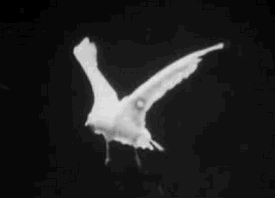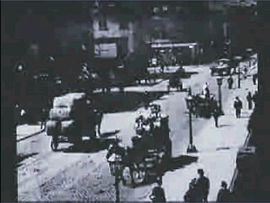









Eadweard Muybridge (1830-1904), an early photographer and inventor, was famous for his photographic motion studies of animals and humans. In the 1870s, Muybridge experimented with instantaneously recording the movements of a galloping horse using a multiple series of cameras to record a horse's gallops.
Muybridge's pictures, published widely in the late 1800s, were often cut into strips and used in a Praxinoscope. The Praxinoscope was the first 'movie machine' that could project a series of images onto a screen. Muybridge's stop-action series of photographs helped lead to his own 1879 invention of the Zoopraxiscope, a primitive motion-picture projector machine. It recreated the illusion of movement by projecting images - rapidly displayed in succession - onto a screen from photos printed on a rotating glass disc.
Etienne-Jules Marey in the 1880s. He was also studying, experimenting, and recording bodies (most often of flying animals, such as pelicans in flight) in motion using photographic means. In 1882, Marey, often claimed to be the 'inventor of cinema,' constructed a camera (or "photographic gun") that could take multiple (12) photographs per second of moving animals or humans - called chronophotography or serial photography. [The term shooting a film was possibly derived from Marey's invention.] He was able to record multiple images of a subject's movement on the same camera plate, rather than the individual images Muybridge had produced.
Marey's chronophotographs were revolutionary. He was soon able to achieve a frame rate of 30 images per second.
Louis Aime Augustin Le Prince was an inventor who is considered by many film historians as the true father of motion pictures. Iin 1888. Le Prince used long rolls of paper film to shoot moving pictures using a single lens camera that he devised and patented. Two short fragments survive of his early motion picture film (one of which was titled Traffic Crossing Leeds Bridge)
George Eastman who had first manufactured photographic dry plates in 1878, provided a more stable type of celluloid film with his concurrent developments in 1888 of sensitized paper roll photographic film (instead of glass plates) and a convenient "Kodak" small box camera (a still camera) that used the roll film. He improved upon the paper roll film with another invention in 1889 - perforated celluloid (synthetic plastic material coated with gelatin) roll-film with photographic emulsion.